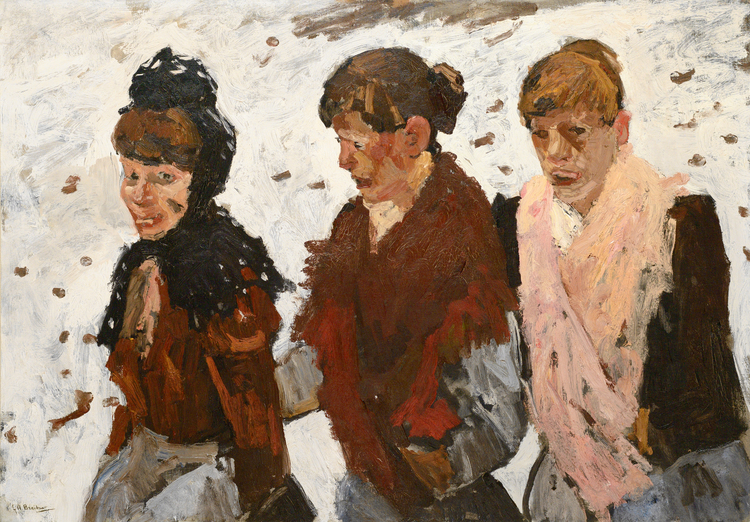G.H. (GEORGE HENDRIK) BREITNER 1857 Rotterdam - 1923 Amsterdam Three Girls in the Snow
Oil / Canvas: 70 x 100 cm
- This artwork can be viewed in our gallery
- Call us for more information: +31 26 361 1876
- World wide shipping available
Details
Three everyday girls walk down the road through the snow arm in arm. The three figures fill the picture, other details are absent. The painting looks like a snapshot, and it is. Besides an artist, Breitner was a talented photographer. The way in which the three girls are recorded in our painting as a moment-in-time snapshot, as random, hurried passers-by, observed in a flash, would not have been possible without photography as a source of inspiration. Breitner aimed to record contemporary city life. He painted it with broad, rough brushstrokes with little detail, using a predominately brown palette. By his extraordinary compositions he pointed the way forward for modern art in the twentieth century.
Width: 100 cm
Collection Dr. J. ten Bokkel
Sale Sotheby's Amsterdam, 24 April 2006, lot 193
Private collection The Netherlands
Breitner, Stedelijk Museum, Amsterdam, Longterm-loan
Breitner. Schilderbeest, Singer Museum, Laren, 15 mei - 8 sept. 2024
Comp. F. van Dijke, "Breitner vs Israels. Vrienden en rivalen", The Hague 2020, p. 102-103 (ill. Meisjes in de sneeuw)
S. Veldink, Singer Museum, Breitner. Schilderbeest, 2024, Laren, p. .. (ill.)
Over G.H. (GEORGE HENDRIK) BREITNER
George Hendrik Breitner began his artistic training at The Hague Academy in 1876. Influenced by the painters of the Hague School and their new realistic approach to nature, Breitner developed a modern and impulsive style of his own and was soon considered an extraordinary talent by fellow artists. He became a member of the painterly society Pulchri Studio and helped paint the Panorama Mesdag (1880-1881), which can still be viewed. Among other things, he painted the cavalry there, practicing on the beach. In 1882 he decided to take a new path. In a letter, he wrote, 'myself, I will paint man on the streets and in the houses the streets and houses they built 't life above all. Le peintre du peuple, I shall try to become or rather I am already because I want it to be.' In the years 1882-1883, he regularly hung out with Vincent van Gogh, with whom he walked the streets a lot 'to go looking for figures and nice cases.' Dissatisfied with the cultural climate in The Hague and attracted to the dynamic and inspiring city of Amsterdam, Breitner left The Hague and joined the Amsterdam Academy in 1886. In that same year, a group of young bohemian writers founded the literary journal 'De Nieuwe Gids,' in which they published their reflections on contemporary artists and passionately propagated the 'L'art pour l'art' ideal in the visual arts and literature. The group, also known as the 'Tachtigers,' included painters like Willem Witsen (1860-1923), writer Adriaan Roland Holst (1888-1976), painter Jan Veth (1864-1925), composer Alfons Diepenbrock (1862-1921) and others. The Tachtigers considered the personal impression much more important than the depiction of realistic details. All the important members were focused on Amsterdam, changing the artistic scene from The Hague to Amsterdam and giving Impressionism a city rather than landscape orientation. Hence Amsterdam Impressionism.
An ambitious painter of modern life, Breitner, along with Isaac Israels (1865-1934), became one of the leading figures of the Amsterdam Impressionist movement. In the eyes of his contemporaries, Breitner was the artist who knew how to depict on canvas those elements that defined the attractive elements of the city. As 'Le peintre du peuple,' he did not want to paint classical themes or create realistic historical paintings in an academic manner, but rather to depict everyday life above all.
Breitner often roamed the streets with his sketchbook and camera to capture the daily lives of construction workers, laborers, maids and playing children. With powerful brushstrokes, he captured what he saw: a fleeting moment, a fragment in time. To convey an impression was painting at its purest; the eye does the rest. Bustling city life would become a recurring subject in his oeuvre. After 1914, he painted less and hardly ever took photographs. He died on June 5, 1923, behind his easel, palette and brush in hand.


